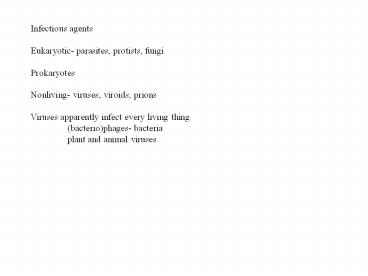Infectious agents - PowerPoint PPT Presentation
1 / 34
Title:
Infectious agents
Description:
Infectious agents Eukaryotic- parasites, protists, fungi Prokaryotes Nonliving- viruses, viroids, prions Viruses apparently infect every living thing – PowerPoint PPT presentation
Number of Views:112
Avg rating:3.0/5.0
Title: Infectious agents
1
Infectious agents Eukaryotic- parasites,
protists, fungi Prokaryotes Nonliving- viruses,
viroids, prions Viruses apparently infect every
living thing (bacterio)phages- bacteria plant
and animal viruses
2
All viruses have a protein capsid Capsid shape
is characteristic of the virus Viruses are naked
Or enveloped
Much smaller than cells
3
(No Transcript)
4
General features of viruses, continued All have
nucleic acid (DNA or RNA, but not both) genome
is very small gene sequences sometimes
overlap Must have genes to make the
capsid replicate itself (special
polymerases) get into and out of the
cell Viruses use the host replication processes
5
What do viruses do to cells? Some viruses kill
the host cell (lytic virulent) Some viruses are
released from living cells (not lytic, but still
productive) Some viruses become integrated into
the DNA of the host (temperate latent
infection. Infection is lysogenic)
6
(No Transcript)
7
Viral life cycles especially well-studied in
bacteriophages, esp. T4
8
Bacteriophage are classified according to host
range attachment site genome (DNA or
RNA) shape effect on host cell
9
Temperate phages can either lyse their host or
replicate with it Bacteriophage lambda (?) is
especially well analyzed Why lytic? Why
lysogenic? Lytic if bacteria are actively
dividing otherwise lysogenic How are viruses
maintained this way?
10
Virus becomes prophage (integrated into host
genome) ? has gene sequences homologous to
sequences in E. coli, and integrates at that
site Is excised in a reverse process In
lysogen, some viral genes are repressed
(prevented from being expressed)
11
How does phage become lytic again? loss or
inactivation of repressor damage to
bacterium Bacteria that already are lysogenic
are immune to infection by the same type
of phage
12
Lysogenic conversion
13
Transduction- phage-mediated genetic transfer Ge
neralized- any bacterial gene can
be transferred Specialized- virus inserted in a
specific site so only genes adjacent to it
are transferred (i.e., temperate phages)
14
Why can phages infect some bacterial strains but
not others? Phage must attach to specific
receptors on host cell Restriction-modification-
prevents the right phage DNA from being
degraded
15
Infectious agents of animals and
plants Analogous biologically to
bacteriophages Taxonomic grouping according
to mode of replication (genome
structure) shape of capsid presence of
envelope Both RNA and DNA genomes wide
variety of arrangement of nucleic acid
16
RNA viruses even more diverse (p. 343)
17
Some other grouping may be more useful, e.g.,
mode of transmission
18
Growing and studying viruses Tissue
culture propagation cytopathic
effect Quantitation plaque assay titration he
magglutination antibody titer
19
adenovirus
Herpes simplex
20
Viruses may be pathogenic or have no
apparent effect May cause acute or persistent
infections
21
Entry of enveloped viruses into animal cells
22
Many viruses have genomes that cannot be
transcribed by host enzymes They must encode
their own How are viruses released? from dead
cells (not actually lysed by virus) budding shed
from host In persistent infections, viruses are
continuously produced by budding Infected person
is a carrier
23
(No Transcript)
24
Retroviruses are analogous to bacteriophage such
as ? Can be integrated (randomly) into host
genome Reverse transcriptase Retroviruses (and
other, DNA viruses) can cause tumors in
susceptible animals
25
Viruses and tumors When viral genome gets
inserted into a host genome, it can cause
changes Activation of host genes Mutation of
host genes If these genes regulate the cell
cycle, this can lead to tumors (e.g.,
proto-oncogenes) Papilloma, herpes, Epstein-Barr
26
Retroviruses and cell transformation Viruses are
integrated into host DNA and later excised May
incorporate regulatory gene Virus polymerase is
error-prone may mutate gene This gene may then
be transferred to a new host
27
Host range the type of organism (or
tissue) that a virus can infect Some can infect
many species (zoonoses) Some can acquire that
wide range through modifications Phenotypic
mixing Mutation
28
(No Transcript)
29
Probably how influenza virus changes so rapidly
30
Viruses infect plants, too Wounds Contaminated
soil Vectors Spread through plasmodesmata in
cell walls Viruses can cause a variety of
pathologies in plants
31
(No Transcript)
32
Other, novel infectious agents Prions-
infectious proteins Viroids- naked, small RNA
molecule replicate autonomously single viroid
can infect cell resistant to proteases and
nucleases only infect plants (as fas as we know)
33
Replication of prions?
34
Prions are species-specific Some apparently can
cross species, e.g., mad cow disease































